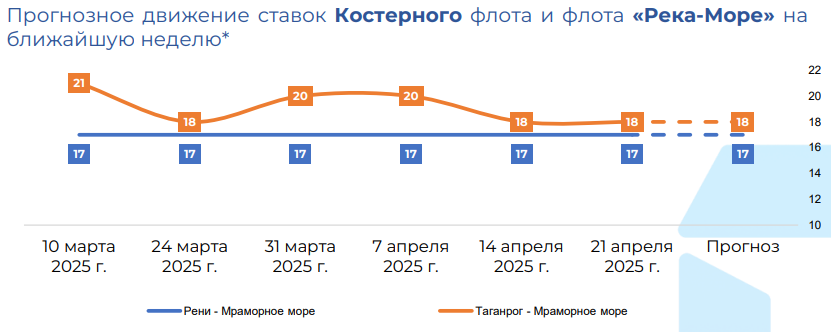In the Black Sea, market activity remains sluggish amid a prolonged downturn. An oversupply of available tonnage, particularly in the small-vessel segment, continues to pressure freight rates. Grain transportation from Ukrainian ports remains limited, while cargo flows from EU countries and Turkey show little momentum. Even where freight rates hold steady on some routes, shipowners are increasingly forced to accept lower rates to keep vessels employed. Russian cargoes are more active, particularly toward the Eastern Mediterranean, but not enough to offset the overall decline in volumes. A reduction in exports of grain and fertilizers, coupled with intensified competition among carriers, is causing freight rates to stagnate and voyage profitability to drop. Market participants are hoping for a gradual recovery after the Easter holidays, though a substantial improvement is not expected in the short term. Future dynamics will largely depend on the appearance of new agricultural shipments and traders’ willingness to re-enter the market under shipowners’ terms.
In the Mediterranean, the freight market remains sluggish. Cargo volumes are limited, and available tonnage remains consistent. Following a brief period of increased activity, deal volumes have again declined. Some European shippers have yet to resume full operations post-holidays. Grain transportation, along with fertilizers and construction materials, occurs sporadically. Most freight rates remain at levels that do not ensure profitability for shipowners. Buyers are focused on minimizing costs and pushing for lower rates, while shipowners aim to maintain at least baseline levels. Isolated voyages from North Africa or the Eastern Mediterranean generate only spot activity, with no significant market impact. Amid intense competition and rising fuel prices, freight rates are showing no signs of upward movement. The market is expected to remain under pressure through the end of April, with meaningful recovery dependent on increased cargo supply and stabilization of logistics chains.
The Azov Sea continues to face pressure due to weak export volumes and low demand for grain transportation toward Turkey. Domestic demand for freight is also subdued. Trader activity is declining amid unfavorable currency rates and falling export prices, leading to frequent idle periods for vessels in the region. The surplus of small river and sea-going vessels only worsens the situation, forcing owners to accept freight rates below operational costs. Coal shipments continue but are insufficient to utilize available tonnage fully. Long-haul offers do appear occasionally but fail to offset losses on shorter, low-yield routes. Local activity is mostly driven by short internal voyages, which are also becoming less attractive due to weak rate levels. In the short term, the market is unlikely to exit its stagnation phase until there are clear signs of export recovery and renewed momentum in grain transportation.

 +380 67 625 91 65
+380 67 625 91 65